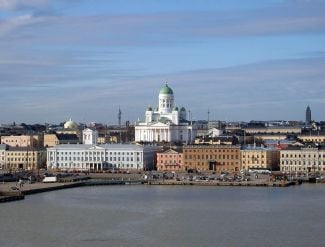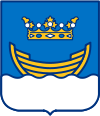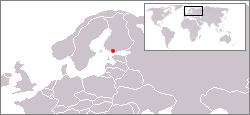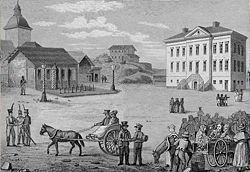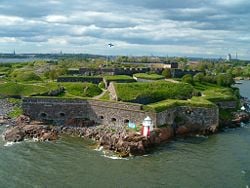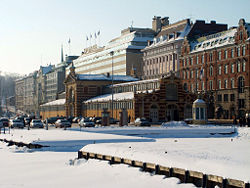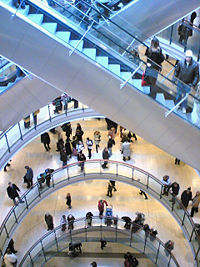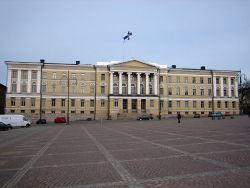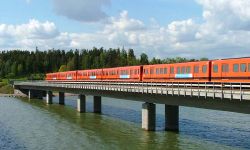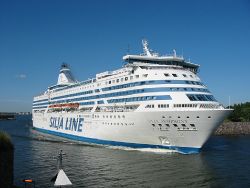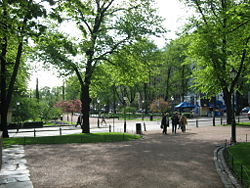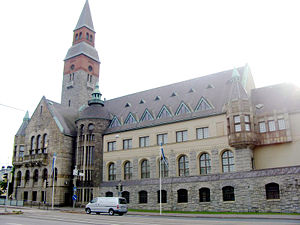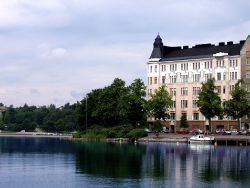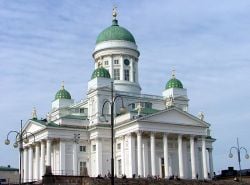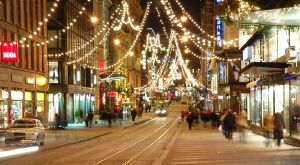Difference between revisions of "Helsinki" - New World Encyclopedia
m (→Demographics) |
|||
| (28 intermediate revisions by 9 users not shown) | |||
| Line 1: | Line 1: | ||
| − | {{ | + | {{Images OK}}{{submitted}}{{approved}}{{Paid}}{{Copyedited}} |
| − | {| | + | {{Infobox City |
| − | | | + | |official_name = City of Helsinki |
| − | + | |native_name = Helsingin kaupunki - Helsingfors stad | |
| − | | | + | |slang names = Stadi, Hesa |
| − | | | + | |motto = |
| − | + | |image_skyline = Suurkirkko Helsinki maaliskuu 2002 IMG 0629.JPG | |
| − | | | + | |imagesize = 325px |
| − | | | + | |image_caption = |
| − | | | + | |image_flag = |
| − | + | |image_shield = Helsinki.vaakuna.svg | |
| − | | | + | |image_map = LocationGreaterHelsinki.png |
| − | | | + | |mapsize = |
| − | + | |map_caption = Location of Helsinki in Northern [[Europe]] | |
| − | | | + | |subdivision_type = [[Countries of the world|Country]] |
| − | + | |subdivision_name = [[Finland]] | |
| − | + | |subdivision_type1 = [[Provinces of Finland|Province]] | |
| − | + | |subdivision_name1 = [[Southern Finland]] | |
| − | + | |subdivision_type2 = [[Regions of Finland|Region]] | |
| − | | [[Finland]] | + | |subdivision_name2 = [[Uusimaa]] |
| − | | | + | |subdivision_type3 = [[Sub-regions of Finland|Sub-region]] |
| − | + | |subdivision_name3 = Helsinki | |
| − | | [[Southern Finland]] | + | |established_title = [[Charter]] |
| − | | | + | |established_date = 1550 |
| − | + | |established_title2 = [[Capital city]] | |
| − | | [[Uusimaa]] | + | |established_date2 = 1812 |
| − | | | + | |area_total_km2 = 187.1 |
| − | + | |area_urban_km2 = 765.6 | |
| − | | Helsinki | + | |area_urban_sq_mi = |
| − | | | + | |area_metro_km2 = 3822.2 |
| − | | | + | |area_metro_sq_mi = |
| − | | | + | |population_as_of = 2016 |
| − | | | + | |population_note = |
| − | | | + | |population_total = 629,512 |
| − | | | + | |population_density_km2 = 2,945.09 |
| − | | | + | |population_density_sq_mi = 7,627.7 |
| − | | | + | |population_metro = 1,441,601 |
| − | | | + | |population_density_metro_km2 = 389.9 |
| − | | | + | |population_density_metro_sq_mi = 1,010 |
| − | | [[ | + | |population_urban = 1,125,136 |
| − | | | + | |population_density_urban_km2 = 1,460.7 |
| − | | | + | |population_density_urban_sq_mi = 3,783 |
| − | | | + | |timezone = [[Eastern European Time|EET]] |
| − | | | + | |utc_offset = +2 |
| − | | | + | |timezone_DST = [[Eastern European Summer Time|EEST]] |
| − | | | + | |utc_offset_DST = +3 |
| − | | | + | |latd=60 |latm=10 |latNS=N |
| − | | | + | |longd=24 |longm=56 |longEW=E |
| − | | | + | |elevation_m = |
| − | | [http://www.hel.fi | + | |elevation_ft = |
| − | |} | + | |postal_code_type = |
| + | |postal_code = | ||
| + | |website = [http://www.hel.fi www.hel.fi] | ||
| + | |footnotes = | ||
| + | |blank_name =[[Languages of Finland|Official languages]] |blank_info =[[Finnish language|Finnish]], [[Swedish language|Swedish]] | ||
| + | }} | ||
| − | '''Helsinki''' (in [[Finnish language|Finnish]]) is the [[capital]] and largest city of [[Finland]]. It is located in the southern part of the country on the shore of the [[Gulf of Finland]], by the [[Baltic Sea]]. The population of the | + | '''Helsinki''' (in [[Finnish language|Finnish]]) is the [[capital]] and largest city of [[Finland]]. It is located in the southern part of the country on the shore of the [[Gulf of Finland]], by the [[Baltic Sea]]. The population of the city itself is approximately 630,000, an urban population of 1.2 million and a metropolitan population of over 1.4 million, making it the most populous municipality and urban area in Finland. |
| − | Founded in 1550 by King [[Gustav I of Sweden]] | + | Founded in 1550 by King [[Gustav I of Sweden]] with the name of ''Helsingfors,'' the town grew in importance after Tzar [[Alexander I of Russia]] moved the capital from [[Turku]] to Helsingfors in the early nineteenth century. In the [[Finnish Civil War]] of 1918, the city suffered relatively little damage. During the Soviet aerial bombardment of the [[Winter War]] (1939-1940) and during the [[Continuation War]] (1941-1944), the city suffered some damage, but not nearly so much as some other European cities. In the second half of the twentieth century, Helsinki developed steadily but relatively late, making it the second sparsest populated capital in Europe behind [[Brussels]]. |
| − | + | {{toc}} | |
| − | + | Helsinki is Finland's [[international]] gateway. The city is the country's nerve center for [[business]], [[finance]], [[fashion]], [[medicine]], [[entertainment]], [[mass media|media]], [[culture]], and [[intellectual|intellectual discourse]]. There is a large and varied collection of [[museum]]s, [[art gallery|galleries]], and performance spaces. | |
| − | |||
| − | Helsinki is Finland's [[international]] gateway. The city is the country's nerve center for [[business]], [[finance]], [[fashion]], [[medicine]], [[entertainment]], [[mass media|media]], [[culture]], and [[intellectual|intellectual discourse]]. There is a large and varied collection of [[museum]]s, [[art gallery|galleries]], and performance spaces | ||
==Names and etymology== | ==Names and etymology== | ||
| − | + | ''Helsingfors'' is the original name of the modern city of Helsinki, and is still the official Swedish name for the city. However, the Finnish name, ''Helsinki,'' (pronounced with the stress on the first syllable ''[['helsiŋki]]'') has been dominant in other languages for decades. The Swedish name Helsingfors comes from the name of the surrounding parish, ''Helsinge'' (source for Finnish ''Helsinki'') and the rapids (in Swedish: ''fors''), which flowed through the original town. The name of ''Helsinge'' is thought to come, according to [[folklore]], from the Swedish dwellers who came from the Swedish province of [[Hälsingland]]. The city is also called ''Stadi'' (from the Swedish word ''stad,'' meaning city) in the [[Helsinki slang|local slang]], and ''Hesa'' by people who don't live in Helsinki. In some subculture communities, especially among [[heavy metal]] fans, the name has recently been humorously misspelled "Hell-sinki." ''Helsset'' is the [[Northern Sami|North Sami]] name for Helsinki. | |
| − | ''Helsingfors'' is the original name of the modern city of Helsinki, and is still the official Swedish name for the city. However, the Finnish name, ''Helsinki'' (pronounced with the stress on the first syllable | ||
==History== | ==History== | ||
| − | + | [[Image:Helsinki 1820.jpg|thumb|left|250px|Central Helsinki in 1820 - Drawing by [[Carl Ludvig Engel]]]] | |
| + | [[Image:Suomenlinna.jpg|thumb|250px|The sea fortress of Suomenlinna, a UNESCO World Heritage Site]] | ||
| + | Founded in 1550 by King [[Gustav I of Sweden]], the town of Helsingfors struggled in its infancy. The fledging settlement was plagued by poverty, wars, and diseases. For a long time it remained as a small, low-key coastal town, overshadowed by the more thriving trade centers in the Baltic region. Construction of the [[Suomenlinna|Sveaborg]] (Suomenlinna) sea fortress helped to improve its status, but it was not until Russia defeated Sweden in the [[Finnish War]] and annexed Finland as the autonomous [[Grand Duchy of Finland]] in 1809, that Helsinki began to truly emerge. | ||
| − | [[ | + | To help reduce the Swedish influence, Tzar [[Alexander I of Russia]] had the capital moved from [[Turku]] ''(Åbo)'' to Helsingfors. The [[Academy of Åbo]], the only university in the country at the time, was also relocated to Helsinki in 1827, eventually becoming the [[University of Helsinki]]. This move consolidated the city's new role, and the following decades saw unprecedented growth and development for the city, creating the prerequisites for the birth of a modern world-class capital in the twentieth century. This transformation is highly apparent in the downtown core, which was rebuilt in the [[neoclassicism|neoclassical]] style to resemble [[St. Petersburg]]. As elsewhere, technological advancements such as railroads and [[industrialization]] were key factors behind the growth. |
| − | + | In the 1918 [[Finnish Civil War]], most of Helsinki fell to the Bolshevik-backed Red Guards along with the rest of southern Finland. The Senate was relocated to [[Vaasa]], although some senators and officials remained hiding in the capital. After the tide of the war turned against the Red forces, German troops, fighting on the same side with the Finnish White Guard, recaptured Helsinki in April. After the White victory, approximately 13,300 Red soldiers and collaborators were confined on the former naval fortress island of [[Suomenlinna]] in Helsinki. Although the civil war left a considerable mark on the society, the standard of living in the country and the city began to improve in the following decade. Renowned architects such as [[Eliel Saarinen]] created Utopian plans for Helsinki, but they were never fully implemented. | |
| − | + | [[Image:Helsinki Market.JPG|thumb|250px|Helsinki Market Square in winter]] | |
| − | In the aerial bombings of the [[Winter War]] (1939- | + | In the aerial bombings of the [[Winter War]] (1939-1940) and the [[Continuation War]] (1941-1944), Helsinki was attacked by Soviet bombers. The most intense air raids took place in the spring of 1944, when 2,000 Soviet planes dropped over 16,000 bombs in and around the city. However, due to a successful air defense the city was spared from the large-scale destruction that many other cities in Europe under similar scale bombings had suffered. Only a few bombs hit populated areas. |
| − | Although much of the first half of the | + | Although much of the first half of the twentieth century was a violent period for Helsinki, the city continued to develop steadily. Modern postwar urbanization did not occur on a large scale in Helsinki until the 1970s, when the population in the metropolitan area tripled, making the [[Helsinki metropolitan area]] one of the fastest growing urban centers in the European Union in the 1990s. |
==Economy== | ==Economy== | ||
| − | [[Image:Helsinki | + | [[Image:Kauppakeskus Kamppi, Helsinki.jpg|200px|left|thumb|The Kauppakeskus Kamppi shopping center in downtown Helsinki]] |
| − | The economy of Helsinki is primarily service-based, having gradually moved away from heavy industry. | + | The economy of Helsinki is primarily service-based, having gradually moved away from heavy industry. However, it still has strong [[paper]], [[textiles]], and [[shipbuilding]] industries. Most large Finnish companies have their head offices and other important functions in the Helsinki metropolitan area, primarily due to international connections, logistics networks, and workforce availability. It is also the location of choice for the regional headquarters of international companies operating in the country. [[Information technology]] and financing sectors form the backbone of Helsinki's economy. |
| − | Helsinki metropolitan area contributes approximately one third of the Finnish gross domestic product. Its GDP per capita is 1.5 times higher than the national average, making Helsinki one of wealthiest capitals in Europe. In 2004, the growth in the region was 3.2 percent. Growth predictions reflect a positive outlook on the future. | + | The Helsinki metropolitan area contributes approximately one third of the Finnish gross domestic product. Its [[GDP]] per capita is 1.5 times higher than the national average, making Helsinki one of wealthiest capitals in Europe. In 2004, the growth in the region was 3.2 percent. Growth predictions reflect a positive outlook on the future. |
| − | + | Helsinki is also the home for the [[Helsinki Stock Exchange]], owned by the [[OMX]] corporation. | |
| − | Helsinki is also | ||
| − | Helsinki is also | + | Helsinki is also unique for a city its size in that there is no part of the town that could be deemed as "[[slum]]," or explicitly inhabited by the poor. However, there is a growing social inequality in the city, and experts have recently warned about the dangers of increasing social challenges. Integration of foreign immigrants into society, infrastructure development, production of public services, and cooperation between Helsinki and its suburbs are seen as major future challenges for the economic development of the region. |
==Services== | ==Services== | ||
===Education=== | ===Education=== | ||
| + | [[Image:Helsingin yliopiston päärakennus.jpg|250px|left|thumb|Main building of the [[University of Helsinki]]]] | ||
Helsinki has 190 comprehensive schools, 41 upper secondary schools, and 15 vocational institutes. Half of the 41 upper secondary schools are private or state-owned, the other half municipal. Higher level education is given in eight universities. | Helsinki has 190 comprehensive schools, 41 upper secondary schools, and 15 vocational institutes. Half of the 41 upper secondary schools are private or state-owned, the other half municipal. Higher level education is given in eight universities. | ||
| − | |||
| − | Institutions of higher education include | + | Institutions of higher education include: the [[University of Helsinki]], [[Helsinki University of Technology]] (located in [[Espoo]]), [[Helsinki School of Economics]], [[Swedish School of Economics and Business Administration]], [[Academy of Fine Arts (Finland)|Academy of Fine Arts]], [[Sibelius Academy]], [[Theater Academy (Finland)|Theater Academy]], [[University of Art and Design Helsinki]], the [[National Defense College (Finland)]], the [[Helsinki Polytechnic Stadia]], [[Helsinki Polytechnic Arcada]], and [[Helsinki Business Polytechnic (Helia)]]. |
===Public transport=== | ===Public transport=== | ||
| − | + | [[Image:Helsinki Metro bridge.jpg|250px|right|thumb|A Helsinki metro train crossing the [[Vuosaari]] metro bridge.]] | |
| − | [[Image:Helsinki Metro bridge.jpg| | + | Public transportation is a hotly debated subject in the local politics of Helsinki. The sparse population of the city has made it one of the most automobile-dependent major cities in Europe. Further development of the public transportation system is a generally recognized need. |
| − | |||
| − | Public transportation is | ||
| − | + | [[public transport|Public transportation]] is mostly managed by [[Helsinki City Transport]], the city's transportation authority. The diverse [[Public transport in Helsinki|public transport system]] consists of [[Helsinki tram|trams]], [[VR commuter rail|light commuter rail]], the [[Helsinki Metro|subway]], [[bus]] lines, and two [[ferry]] lines. The [[Helsinki Metropolitan Area Council]] manages traffic to the surrounding municipalities of [[Espoo]], [[Vantaa]], and [[Kauniainen]]. | |
| − | + | The [[Helsinki Metro]], opened in 1982, is so far the only subway system in Finland. In 2006, the construction of the long debated [[Länsimetro|extension]] of the subway system west into Espoo was approved, and serious debate about an eastern extension into [[Sipoo]] has taken place. | |
| − | [[Image:Silja Symphony.jpg| | + | [[Image:Silja Symphony.jpg|250px|left|thumb|[[M/S Silja Symphony]] leaving from Helsinki.]] |
Air traffic is handled primarily from the international [[Helsinki-Vantaa Airport]], located approximately 11.8 miles north of Helsinki's downtown area, in the neighboring city of Vantaa. The airport provides scheduled non-stop flights to many important cities in [[Europe]], [[Asia]], and [[North America]]. Helsinki's second airport, [[Malmi Airport]], is generally used for general and private aviation. | Air traffic is handled primarily from the international [[Helsinki-Vantaa Airport]], located approximately 11.8 miles north of Helsinki's downtown area, in the neighboring city of Vantaa. The airport provides scheduled non-stop flights to many important cities in [[Europe]], [[Asia]], and [[North America]]. Helsinki's second airport, [[Malmi Airport]], is generally used for general and private aviation. | ||
| − | Ferry connections to [[Tallinn]] and [[Stockholm]] are serviced by various companies. [[Finnlines]] passenger-freight ferries to [[Travemünde]], [[Germany]] are also available, while Tallink began service to [[Rostock]], Germany in 2007. [[Copterline]] has provided fast helicopter flights to Tallinn, however they have suspended service indefinitely at this time | + | Ferry connections to [[Tallinn]] and [[Stockholm]] are serviced by various companies. [[Finnlines]] passenger-freight ferries to [[Travemünde]], [[Germany]] are also available, while Tallink began service to [[Rostock]], Germany in 2007. [[Copterline]] has provided fast helicopter flights to Tallinn in the past, however, they have suspended service indefinitely at this time. |
| − | |||
| − | |||
| − | |||
==Politics== | ==Politics== | ||
| − | + | Like in all Finnish municipalities, the city council in Helsinki is the main decision-making organ in local politics, dealing with issues such as city planning, schools, health care, and public transportation. The 85-member council is elected every fourth year by municipal elections. The mayor of Helsinki is appointed by the city council. | |
| − | Like in all Finnish municipalities, the city council in Helsinki is the main decision-making organ in local politics, dealing with issues such as city planning, schools, health care, and public | ||
| − | Traditionally, the conservative [[National Coalition Party]] (Kokoomus) has been the biggest party in Helsinki's local politics, with the [[Social Democrats]] being the second biggest. In the 2000 election the [[Green League]], for which Helsinki is the strongest area of support nationally, gained the position of the second most popular party. In 2004 however, the Social Democrats regained that position. Currently these three groups hold about 75 | + | Traditionally, the conservative [[National Coalition Party]] (Kokoomus) has been the biggest party in Helsinki's local politics, with the [[Social Democrats]] being the second biggest. In the 2000 election the [[Green League]], for which Helsinki is the strongest area of support nationally, gained the position of the second most popular party. In 2004 however, the Social Democrats regained that position. Currently these three groups hold about 75 percent of the seats. |
| − | The [[Left Alliance]] and the [[Swedish People's Party]] both have | + | The [[Left Alliance]] and the [[Swedish People's Party]] both have about seven to eight percent of the seats. The latter's support has been steadily declining over the years, most likely because of the diminishing proportion of Swedish speakers in Helsinki. The [[Center Party]] of Finland, despite being one of the three major parties in nationwide politics, has relatively little support in Helsinki as it does in most other big cities. |
| − | == | + | ==Demographics== |
| − | + | [[Image:Esplanadin puisto.jpg|thumb|250px|Helsinki's Central Park]] | |
| + | Helsinki spreads around a number of bays and peninsulas and over a number of islands. The inner city area occupies a southern peninsula, which is rarely referred to by its actual name [[Vironniemi]]. Population density in certain parts of Helsinki's inner city area is high, but as a whole Helsinki ranks as quite sparsely populated in comparison to other European capital cities. Much of Helsinki outside the inner-city area consists of postwar suburbs separated from each other by patches of forests. A narrow, 6.2-mile-long Helsinki Central Park that stretches from the inner city to the northern border of Helsinki is an important recreational area for the residents. | ||
| − | + | The city has Finland's largest [[immigration|foreign]] population in terms of real numbers and [[percentage]] of population. There are over 130 [[nationality|nationalities]] residing in Helsinki. Of these, the largest group include citizens from [[Russia]], [[Estonia]], [[Sweden]], [[Somalia]], [[Serbia]], [[People's Republic of China|China]], [[Iraq]], and [[Germany]]. | |
| − | + | The Helsinki urban region contains the neighboring cities of [[Espoo]], [[Vantaa]], and [[Kauniainen]], which are together called the [[Greater Helsinki|Capital Region]]. | |
| − | [[ | ||
| − | |||
| − | |||
| − | + | Some notable islands in Helsinki include [[Seurasaari]], [[Lauttasaari]], and [[Korkeasaari]] – which is also home to the country's biggest zoo – as well as the fortress island of [[Suomenlinna]] (Sveaborg), and the military island of [[Santahamina]]. | |
| − | |||
| − | Some notable islands in Helsinki include [[Seurasaari]], [[Lauttasaari]], and [[Korkeasaari]] – which is also the country's biggest zoo – as well as the fortress island of [[Suomenlinna]] (Sveaborg) and the military island of [[Santahamina]]. | ||
==Climate== | ==Climate== | ||
| − | The city's climate is humid continental, meaning the average of the coldest month is no more than 26° F Summers are usually warm, although temperatures over 86° F are uncommon. Helsinki is situated on approximately the same latitude as [[Anchorage]], [[Alaska]], making it the second northernmost capital in the world after [[Reykjavík]], [[Iceland]], | + | The city's climate is humid continental, meaning the average of the coldest month is no more than 26° F. Summers are usually warm, although temperatures over 86° F are uncommon. Helsinki is situated on approximately the same latitude as [[Anchorage]], [[Alaska]], making it the second northernmost capital in the world after [[Reykjavík]], [[Iceland]]. Thus, Helsinki has very short days in winter. |
==Culture== | ==Culture== | ||
| − | [[Image: | + | [[Image:National Museum of Finland.jpg|thumb|300px|The National Museum of Finland]] |
| − | Helsinki can also be considered Finland's | + | Helsinki can also be considered Finland's cultural capital. The biggest historical museum in Helsinki is the [[National Museum of Finland]], which displays a vast historical collection from prehistoric times to the twentieth century. The museum building itself, a romantic-style, neo-medieval castle, is a tourist attraction. Another major historical museum is the [[Helsinki City Museum]], which introduces visitors to Helsinki's 500-year history. The [[University of Helsinki]] also has several significant museums, including the University Museum and the Natural History Museum. |
| − | |||
| − | The biggest historical museum in Helsinki is the [[National Museum of Finland]], which displays a vast historical collection from prehistoric times to the twentieth century. The museum building itself, a | ||
| − | |||
| − | |||
| − | + | The Finnish National Gallery consists of three museums: [[Ateneum|Ateneum Art Museum]] for classical Finnish art, Sinebrychoff Art Museum for classical European art, and the [[Kiasma|Kiasma Art Museum]] for modern art. The old Ateneum, a Neo-Renaissance palace from the nineteenth century, is one of the city's major historical buildings, whereas the highly modern Kiasma, finds people disagreeing about its beauty. | |
| − | Helsinki | + | Helsinki has three major theaters: The [[Finnish National Theater]], the [[Helsinki City Theater]], and the Finland Swedish [[Svenska Teatern]]. The city's main musical venues are the [[Finnish National Opera]] and the [[Finlandia Hall|Finlandia concert-hall]]. Larger concerts and events are usually held at one of the city's two big ice-hockey arenas: the [[Hartwall Areena]] or the [[Helsingin Jäähalli]]. Helsinki has Finland's largest [[Helsinki Fair Center|fair center]]. |
| − | + | Helsinki is also known for its active [[Helsinki ICT and digital culture scene|ICT and digital cultures scene in Greater Helsinki]]. The biggest subscription newspaper in Finland and the [[Nordic countries]], ''[[Helsingin Sanomat]],'' is published daily out of Helsinki. | |
===Architecture=== | ===Architecture=== | ||
| − | [[Image:HelsinkiToolonlahti.jpg| | + | [[Image:HelsinkiToolonlahti.jpg|right|250px|thumb|The view across summertime Kaisaniemenlahti.]] |
| − | [[Carl Ludvig Engel]] (1778-1840) designed several [[Neoclassical architecture|neo-classical]] buildings in Helsinki | + | [[Carl Ludvig Engel]] (1778-1840) designed several [[Neoclassical architecture|neo-classical]] buildings in Helsinki after being selected to plan a new city center all on his own. The central point of Engel's city plan is the [[Helsinki Senate Square|Senate Square]], surrounded by the Government's Palace, the main building of the University, and the enormous [[Helsinki Cathedral|Cathedral]], which was finished in 1852, 12 years after Engel's death. Engels' neo-classical plan of the city center later gave Helsinki the [[epithet]] ''The White City of The North.'' |
| − | [[Image:Helsinki Cathedral in July 2004.jpg|thumb|right|The [[Helsinki Cathedral]] | + | [[Image:Helsinki Cathedral in July 2004.jpg|thumb|right|250px|The [[Helsinki Cathedral]] is the most prominent building in the city.]] |
| − | Helsinki is, however, perhaps even more famous for its numerous [[Art Nouveau]] | + | Helsinki is, however, perhaps even more famous for its numerous [[Art Nouveau]] buildings, designed in the early 1900s and strongly influenced by the [[Kalevala]], Finland's national epic, which is a very popular theme in the national romantic art of that era. Helsinki's Art Nouveau style is also featured in large residential areas such as Katajanokka and Ullanlinna. The master of the Finnish Art Nouveau was [[Eliel Saarinen]] (1873-1950), whose architectural masterpiece was the Helsinki central railway station. |
| − | + | Helsinki also features several buildings by the world-renowned Finnish architect [[Alvar Aalto]] (1898-1976), attributed as one of the pioneers in [[functionalism]]. Aalto's buildings, such as the headquarters of the paper company Enso and the concert and congress house [[Finlandia Hall]], have sparked much debate amongst Helsinki's inhabitants. | |
| − | Helsinki also features several buildings by the world-renowned Finnish architect [[Alvar Aalto]] (1898-1976), attributed as one of the pioneers in [[functionalism]] | ||
| − | + | Helsinki's neoclassical buildings were often used as a backdrop for scenes set to take place in the [[Soviet Union]] in many [[Cold War]] era Hollywood movies. Some of the more notable ones are ''[[The Kremlin Letter]]'' (1970), ''[[Reds (film)|Reds]]'' (1981), and ''[[Gorky Park]]'' (1983). Because some of the streetscapes were reminiscent of [[St.Petersburg|Leningrad]]'s and [[Moscow]]'s old buildings, they were used in the productions - much to some residents' dismay. At the same time the government secretly briefed its white-collar workers to make producing these—often clearly Soviet-negative films—in Helsinki as hard as possible, due to diplomatic pressure from Moscow. | |
| − | |||
| − | |||
| − | |||
| − | |||
| − | |||
===Sports=== | ===Sports=== | ||
| − | Helsinki has a long tradition of sports. The city gained much of its initial international recognition during the [[1952 Summer Olympics]], and since then it has been very open to arranging sporting events. Helsinki hosts fairly successful local teams in both of the most | + | Helsinki has a long tradition of sports. The city gained much of its initial international recognition during the [[1952 Summer Olympics]], and since then it has been very open to arranging sporting events. Helsinki hosts fairly successful local teams in both of the most popular team-sports in [[Finland]]: [[football]] and [[ice hockey]]. |
| − | |||
| − | |||
| − | |||
| − | |||
| − | |||
| − | |||
| − | |||
| − | |||
| − | |||
| − | |||
| − | |||
| − | |||
| − | |||
| − | |||
| − | |||
| − | |||
| − | |||
| − | |||
| − | |||
| − | |||
| − | |||
| − | |||
| − | |||
| − | |||
| − | |||
| − | |||
| − | |||
| − | |||
| − | |||
| − | |||
| − | |||
| − | |||
| − | |||
| − | |||
| − | |||
| − | |||
| − | |||
| − | |||
| − | |||
| − | |||
| − | |||
| − | |||
| − | |||
| − | |||
| − | |||
==Tourism== | ==Tourism== | ||
| − | [[Image:Aleksi61wb.jpg|thumb| | + | [[Image:Aleksi61wb.jpg|thumb|right|300px|''Joulukatu,'' Finnish for "Christmas street"]] |
| − | [[ | + | Many of Helsinki's main attractions are also related to the sea, including the [[Suomenlinna]] naval fortress, a [[UNESCO]] [[World Heritage site]], and [[Seurasaari]] Island with its parks and open-air museum. Locals often spend sunny days at the Hietaniemi Beach (often simply called ''Hietsu''), Helsinki's main beach in the district of Töölö. |
| − | |||
| − | |||
| − | |||
| − | |||
| − | Helsinki's | + | In winter, Helsinki's northern position makes it dark for most of the day, leading to a tradition of impressive lighting, such as the classic [[Aleksanterinkatu]]'s Christmas street ''(Joulukatu).'' During the coldest months of the winter it is common for Helsinkians to go for walks on the frozen sea. There are also many places for [[ice swimming]] along the coast, some with saunas. |
| − | + | Helsinki is also the home of the [[Linnanmäki]] amusement park, which features five roller coasters and many other rides, including the world's first [[Intamin]] ZacSpin rollercoaster. | |
| − | |||
| − | |||
| − | |||
| − | Helsinki is also the home of the [[Linnanmäki]] amusement park, which features five | ||
==Gallery== | ==Gallery== | ||
<div align="center"> | <div align="center"> | ||
<gallery> | <gallery> | ||
| − | + | Image:Helsinki Railway Station 20050604.jpg|[[Helsinki Central railway station]] | |
| − | + | Image:Finnish National Theatre.jpg|[[Finnish National Theater]] | |
| − | + | Image:Uspenski_Cathedral_Helsinki.jpg|The [[Uspenski Cathedral|Uspenski Orthodox cathedral]] | |
| − | + | Image:Temppeliaukio Church 3.jpg|Altar of Temppeliaukio Church that is built underground | |
| − | Image:Helsinki Railway Station 20050604.jpg|[[Helsinki Central railway station]] | + | Image:Senaatintori joulukuisena aamuna 2004.jpg|The Senaatintori square on a winter morning |
| − | + | Image:Stockmann department store in Helsinki at dawn in December 2004.jpg|[[Stockmann]] department store along the [[Aleksanterinkatu]]'s Christmas street | |
| − | Image:Finnish National Theatre.jpg|[[Finnish National | ||
| − | |||
| − | Image:Uspenski_Cathedral_Helsinki.jpg|The [[Uspenski Cathedral|Uspenski Orthodox cathedral]] | ||
| − | Image:Temppeliaukio Church 3.jpg|Altar of Temppeliaukio Church that is built underground | ||
| − | |||
| − | Image:Senaatintori joulukuisena aamuna 2004.jpg|The Senaatintori square on a winter morning | ||
| − | Image:Stockmann department store in Helsinki at dawn in December 2004.jpg|[[Stockmann]] department store along the [[Aleksanterinkatu]]'s Christmas street | ||
| − | |||
| − | |||
| − | |||
</gallery> | </gallery> | ||
</div> | </div> | ||
==References== | ==References== | ||
| − | *Renouf, Norman. ''Insight | + | * Renouf, Norman. ''Insight Pocket Guide Helsinki.'' Insight Guides; Pap/Map edition, 2005. ISBN 978-9812581372 |
| − | *Symington, Andy. ''Lonely Planet Finland'' | + | * Symington, Andy. ''Lonely Planet Finland.'' Lonely Planet Publications, 2006. ISBN 978-1740597913 |
| − | *Thomas, Daniel C. ''The Helsinki Effect: International Norms, Human Rights, and the Demise of Communism'' | + | * Thomas, Daniel C. ''The Helsinki Effect: International Norms, Human Rights, and the Demise of Communism.'' Princeton University Press, 2001. ISBN 978-0691048598 |
| − | *Wallis, Nigel. ''Helsinki: The Bradt Travel | + | * Wallis, Nigel. ''Helsinki: The Bradt Travel Guide.'' Bradt Travel Guides; First edition, 2007. ISBN 978-1841621845 |
| − | + | {{credit|111259315}} | |
| − | |||
| − | |||
| − | |||
| − | + | [[Category:Cities]] | |
| − | + | [[Category:Geography]] | |
| − | |||
| − | [[Category: | ||
| − | |||
| − | |||
Latest revision as of 22:00, 26 August 2016
| City of Helsinki Helsingin kaupunki - Helsingfors stad |
|||
|
|||
| Location of Helsinki in Northern Europe | |||
| Coordinates: 60°10′N 24°56′E | |||
|---|---|---|---|
| Country | Finland | ||
| Province | Southern Finland | ||
| Region | Uusimaa | ||
| Sub-region | Helsinki | ||
| Charter | 1550 | ||
| Capital city | 1812 | ||
| Area | |||
| - City | 187.1 km² (72.2 sq mi) | ||
| - Urban | 765.6 km² (295.6 sq mi) | ||
| - Metro | 3,822.2 km² (1,475.8 sq mi) | ||
| Population (2016) | |||
| - City | 629,512 | ||
| - Density | 2,945.09/km² (7,627.7/sq mi) | ||
| - Urban | 1,125,136 | ||
| - Urban Density | 1,460.7/km² (3,783/sq mi) | ||
| - Metro | 1,441,601 | ||
| - Metro Density | 389.9/km² (1,010/sq mi) | ||
| Time zone | EET (UTC+2) | ||
| - Summer (DST) | EEST (UTC+3) | ||
| Official languages | Finnish, Swedish | ||
| Website: www.hel.fi | |||
Helsinki (in Finnish) is the capital and largest city of Finland. It is located in the southern part of the country on the shore of the Gulf of Finland, by the Baltic Sea. The population of the city itself is approximately 630,000, an urban population of 1.2 million and a metropolitan population of over 1.4 million, making it the most populous municipality and urban area in Finland.
Founded in 1550 by King Gustav I of Sweden with the name of Helsingfors, the town grew in importance after Tzar Alexander I of Russia moved the capital from Turku to Helsingfors in the early nineteenth century. In the Finnish Civil War of 1918, the city suffered relatively little damage. During the Soviet aerial bombardment of the Winter War (1939-1940) and during the Continuation War (1941-1944), the city suffered some damage, but not nearly so much as some other European cities. In the second half of the twentieth century, Helsinki developed steadily but relatively late, making it the second sparsest populated capital in Europe behind Brussels.
Helsinki is Finland's international gateway. The city is the country's nerve center for business, finance, fashion, medicine, entertainment, media, culture, and intellectual discourse. There is a large and varied collection of museums, galleries, and performance spaces.
Names and etymology
Helsingfors is the original name of the modern city of Helsinki, and is still the official Swedish name for the city. However, the Finnish name, Helsinki, (pronounced with the stress on the first syllable 'helsiŋki) has been dominant in other languages for decades. The Swedish name Helsingfors comes from the name of the surrounding parish, Helsinge (source for Finnish Helsinki) and the rapids (in Swedish: fors), which flowed through the original town. The name of Helsinge is thought to come, according to folklore, from the Swedish dwellers who came from the Swedish province of Hälsingland. The city is also called Stadi (from the Swedish word stad, meaning city) in the local slang, and Hesa by people who don't live in Helsinki. In some subculture communities, especially among heavy metal fans, the name has recently been humorously misspelled "Hell-sinki." Helsset is the North Sami name for Helsinki.
History
Founded in 1550 by King Gustav I of Sweden, the town of Helsingfors struggled in its infancy. The fledging settlement was plagued by poverty, wars, and diseases. For a long time it remained as a small, low-key coastal town, overshadowed by the more thriving trade centers in the Baltic region. Construction of the Sveaborg (Suomenlinna) sea fortress helped to improve its status, but it was not until Russia defeated Sweden in the Finnish War and annexed Finland as the autonomous Grand Duchy of Finland in 1809, that Helsinki began to truly emerge.
To help reduce the Swedish influence, Tzar Alexander I of Russia had the capital moved from Turku (Åbo) to Helsingfors. The Academy of Åbo, the only university in the country at the time, was also relocated to Helsinki in 1827, eventually becoming the University of Helsinki. This move consolidated the city's new role, and the following decades saw unprecedented growth and development for the city, creating the prerequisites for the birth of a modern world-class capital in the twentieth century. This transformation is highly apparent in the downtown core, which was rebuilt in the neoclassical style to resemble St. Petersburg. As elsewhere, technological advancements such as railroads and industrialization were key factors behind the growth.
In the 1918 Finnish Civil War, most of Helsinki fell to the Bolshevik-backed Red Guards along with the rest of southern Finland. The Senate was relocated to Vaasa, although some senators and officials remained hiding in the capital. After the tide of the war turned against the Red forces, German troops, fighting on the same side with the Finnish White Guard, recaptured Helsinki in April. After the White victory, approximately 13,300 Red soldiers and collaborators were confined on the former naval fortress island of Suomenlinna in Helsinki. Although the civil war left a considerable mark on the society, the standard of living in the country and the city began to improve in the following decade. Renowned architects such as Eliel Saarinen created Utopian plans for Helsinki, but they were never fully implemented.
In the aerial bombings of the Winter War (1939-1940) and the Continuation War (1941-1944), Helsinki was attacked by Soviet bombers. The most intense air raids took place in the spring of 1944, when 2,000 Soviet planes dropped over 16,000 bombs in and around the city. However, due to a successful air defense the city was spared from the large-scale destruction that many other cities in Europe under similar scale bombings had suffered. Only a few bombs hit populated areas.
Although much of the first half of the twentieth century was a violent period for Helsinki, the city continued to develop steadily. Modern postwar urbanization did not occur on a large scale in Helsinki until the 1970s, when the population in the metropolitan area tripled, making the Helsinki metropolitan area one of the fastest growing urban centers in the European Union in the 1990s.
Economy
The economy of Helsinki is primarily service-based, having gradually moved away from heavy industry. However, it still has strong paper, textiles, and shipbuilding industries. Most large Finnish companies have their head offices and other important functions in the Helsinki metropolitan area, primarily due to international connections, logistics networks, and workforce availability. It is also the location of choice for the regional headquarters of international companies operating in the country. Information technology and financing sectors form the backbone of Helsinki's economy.
The Helsinki metropolitan area contributes approximately one third of the Finnish gross domestic product. Its GDP per capita is 1.5 times higher than the national average, making Helsinki one of wealthiest capitals in Europe. In 2004, the growth in the region was 3.2 percent. Growth predictions reflect a positive outlook on the future. Helsinki is also the home for the Helsinki Stock Exchange, owned by the OMX corporation.
Helsinki is also unique for a city its size in that there is no part of the town that could be deemed as "slum," or explicitly inhabited by the poor. However, there is a growing social inequality in the city, and experts have recently warned about the dangers of increasing social challenges. Integration of foreign immigrants into society, infrastructure development, production of public services, and cooperation between Helsinki and its suburbs are seen as major future challenges for the economic development of the region.
Services
Education
Helsinki has 190 comprehensive schools, 41 upper secondary schools, and 15 vocational institutes. Half of the 41 upper secondary schools are private or state-owned, the other half municipal. Higher level education is given in eight universities.
Institutions of higher education include: the University of Helsinki, Helsinki University of Technology (located in Espoo), Helsinki School of Economics, Swedish School of Economics and Business Administration, Academy of Fine Arts, Sibelius Academy, Theater Academy, University of Art and Design Helsinki, the National Defense College (Finland), the Helsinki Polytechnic Stadia, Helsinki Polytechnic Arcada, and Helsinki Business Polytechnic (Helia).
Public transport
Public transportation is a hotly debated subject in the local politics of Helsinki. The sparse population of the city has made it one of the most automobile-dependent major cities in Europe. Further development of the public transportation system is a generally recognized need.
Public transportation is mostly managed by Helsinki City Transport, the city's transportation authority. The diverse public transport system consists of trams, light commuter rail, the subway, bus lines, and two ferry lines. The Helsinki Metropolitan Area Council manages traffic to the surrounding municipalities of Espoo, Vantaa, and Kauniainen.
The Helsinki Metro, opened in 1982, is so far the only subway system in Finland. In 2006, the construction of the long debated extension of the subway system west into Espoo was approved, and serious debate about an eastern extension into Sipoo has taken place.
Air traffic is handled primarily from the international Helsinki-Vantaa Airport, located approximately 11.8 miles north of Helsinki's downtown area, in the neighboring city of Vantaa. The airport provides scheduled non-stop flights to many important cities in Europe, Asia, and North America. Helsinki's second airport, Malmi Airport, is generally used for general and private aviation.
Ferry connections to Tallinn and Stockholm are serviced by various companies. Finnlines passenger-freight ferries to Travemünde, Germany are also available, while Tallink began service to Rostock, Germany in 2007. Copterline has provided fast helicopter flights to Tallinn in the past, however, they have suspended service indefinitely at this time.
Politics
Like in all Finnish municipalities, the city council in Helsinki is the main decision-making organ in local politics, dealing with issues such as city planning, schools, health care, and public transportation. The 85-member council is elected every fourth year by municipal elections. The mayor of Helsinki is appointed by the city council.
Traditionally, the conservative National Coalition Party (Kokoomus) has been the biggest party in Helsinki's local politics, with the Social Democrats being the second biggest. In the 2000 election the Green League, for which Helsinki is the strongest area of support nationally, gained the position of the second most popular party. In 2004 however, the Social Democrats regained that position. Currently these three groups hold about 75 percent of the seats.
The Left Alliance and the Swedish People's Party both have about seven to eight percent of the seats. The latter's support has been steadily declining over the years, most likely because of the diminishing proportion of Swedish speakers in Helsinki. The Center Party of Finland, despite being one of the three major parties in nationwide politics, has relatively little support in Helsinki as it does in most other big cities.
Demographics
Helsinki spreads around a number of bays and peninsulas and over a number of islands. The inner city area occupies a southern peninsula, which is rarely referred to by its actual name Vironniemi. Population density in certain parts of Helsinki's inner city area is high, but as a whole Helsinki ranks as quite sparsely populated in comparison to other European capital cities. Much of Helsinki outside the inner-city area consists of postwar suburbs separated from each other by patches of forests. A narrow, 6.2-mile-long Helsinki Central Park that stretches from the inner city to the northern border of Helsinki is an important recreational area for the residents.
The city has Finland's largest foreign population in terms of real numbers and percentage of population. There are over 130 nationalities residing in Helsinki. Of these, the largest group include citizens from Russia, Estonia, Sweden, Somalia, Serbia, China, Iraq, and Germany.
The Helsinki urban region contains the neighboring cities of Espoo, Vantaa, and Kauniainen, which are together called the Capital Region.
Some notable islands in Helsinki include Seurasaari, Lauttasaari, and Korkeasaari – which is also home to the country's biggest zoo – as well as the fortress island of Suomenlinna (Sveaborg), and the military island of Santahamina.
Climate
The city's climate is humid continental, meaning the average of the coldest month is no more than 26° F. Summers are usually warm, although temperatures over 86° F are uncommon. Helsinki is situated on approximately the same latitude as Anchorage, Alaska, making it the second northernmost capital in the world after Reykjavík, Iceland. Thus, Helsinki has very short days in winter.
Culture
Helsinki can also be considered Finland's cultural capital. The biggest historical museum in Helsinki is the National Museum of Finland, which displays a vast historical collection from prehistoric times to the twentieth century. The museum building itself, a romantic-style, neo-medieval castle, is a tourist attraction. Another major historical museum is the Helsinki City Museum, which introduces visitors to Helsinki's 500-year history. The University of Helsinki also has several significant museums, including the University Museum and the Natural History Museum.
The Finnish National Gallery consists of three museums: Ateneum Art Museum for classical Finnish art, Sinebrychoff Art Museum for classical European art, and the Kiasma Art Museum for modern art. The old Ateneum, a Neo-Renaissance palace from the nineteenth century, is one of the city's major historical buildings, whereas the highly modern Kiasma, finds people disagreeing about its beauty.
Helsinki has three major theaters: The Finnish National Theater, the Helsinki City Theater, and the Finland Swedish Svenska Teatern. The city's main musical venues are the Finnish National Opera and the Finlandia concert-hall. Larger concerts and events are usually held at one of the city's two big ice-hockey arenas: the Hartwall Areena or the Helsingin Jäähalli. Helsinki has Finland's largest fair center.
Helsinki is also known for its active ICT and digital cultures scene in Greater Helsinki. The biggest subscription newspaper in Finland and the Nordic countries, Helsingin Sanomat, is published daily out of Helsinki.
Architecture
Carl Ludvig Engel (1778-1840) designed several neo-classical buildings in Helsinki after being selected to plan a new city center all on his own. The central point of Engel's city plan is the Senate Square, surrounded by the Government's Palace, the main building of the University, and the enormous Cathedral, which was finished in 1852, 12 years after Engel's death. Engels' neo-classical plan of the city center later gave Helsinki the epithet The White City of The North.
Helsinki is, however, perhaps even more famous for its numerous Art Nouveau buildings, designed in the early 1900s and strongly influenced by the Kalevala, Finland's national epic, which is a very popular theme in the national romantic art of that era. Helsinki's Art Nouveau style is also featured in large residential areas such as Katajanokka and Ullanlinna. The master of the Finnish Art Nouveau was Eliel Saarinen (1873-1950), whose architectural masterpiece was the Helsinki central railway station.
Helsinki also features several buildings by the world-renowned Finnish architect Alvar Aalto (1898-1976), attributed as one of the pioneers in functionalism. Aalto's buildings, such as the headquarters of the paper company Enso and the concert and congress house Finlandia Hall, have sparked much debate amongst Helsinki's inhabitants.
Helsinki's neoclassical buildings were often used as a backdrop for scenes set to take place in the Soviet Union in many Cold War era Hollywood movies. Some of the more notable ones are The Kremlin Letter (1970), Reds (1981), and Gorky Park (1983). Because some of the streetscapes were reminiscent of Leningrad's and Moscow's old buildings, they were used in the productions - much to some residents' dismay. At the same time the government secretly briefed its white-collar workers to make producing these—often clearly Soviet-negative films—in Helsinki as hard as possible, due to diplomatic pressure from Moscow.
Sports
Helsinki has a long tradition of sports. The city gained much of its initial international recognition during the 1952 Summer Olympics, and since then it has been very open to arranging sporting events. Helsinki hosts fairly successful local teams in both of the most popular team-sports in Finland: football and ice hockey.
Tourism
Many of Helsinki's main attractions are also related to the sea, including the Suomenlinna naval fortress, a UNESCO World Heritage site, and Seurasaari Island with its parks and open-air museum. Locals often spend sunny days at the Hietaniemi Beach (often simply called Hietsu), Helsinki's main beach in the district of Töölö.
In winter, Helsinki's northern position makes it dark for most of the day, leading to a tradition of impressive lighting, such as the classic Aleksanterinkatu's Christmas street (Joulukatu). During the coldest months of the winter it is common for Helsinkians to go for walks on the frozen sea. There are also many places for ice swimming along the coast, some with saunas.
Helsinki is also the home of the Linnanmäki amusement park, which features five roller coasters and many other rides, including the world's first Intamin ZacSpin rollercoaster.
Gallery
ReferencesISBN links support NWE through referral fees
- Renouf, Norman. Insight Pocket Guide Helsinki. Insight Guides; Pap/Map edition, 2005. ISBN 978-9812581372
- Symington, Andy. Lonely Planet Finland. Lonely Planet Publications, 2006. ISBN 978-1740597913
- Thomas, Daniel C. The Helsinki Effect: International Norms, Human Rights, and the Demise of Communism. Princeton University Press, 2001. ISBN 978-0691048598
- Wallis, Nigel. Helsinki: The Bradt Travel Guide. Bradt Travel Guides; First edition, 2007. ISBN 978-1841621845
Credits
New World Encyclopedia writers and editors rewrote and completed the Wikipedia article in accordance with New World Encyclopedia standards. This article abides by terms of the Creative Commons CC-by-sa 3.0 License (CC-by-sa), which may be used and disseminated with proper attribution. Credit is due under the terms of this license that can reference both the New World Encyclopedia contributors and the selfless volunteer contributors of the Wikimedia Foundation. To cite this article click here for a list of acceptable citing formats.The history of earlier contributions by wikipedians is accessible to researchers here:
The history of this article since it was imported to New World Encyclopedia:
Note: Some restrictions may apply to use of individual images which are separately licensed.
